Rural education plays a crucial role in the development of villages and small towns by providing knowledge and skills essential for socio-economic progress.
However, it faces several challenges, including poor infrastructure, lack of qualified teachers, and inadequate resources.
Rural Education: Bridging the Gap for a Better Future
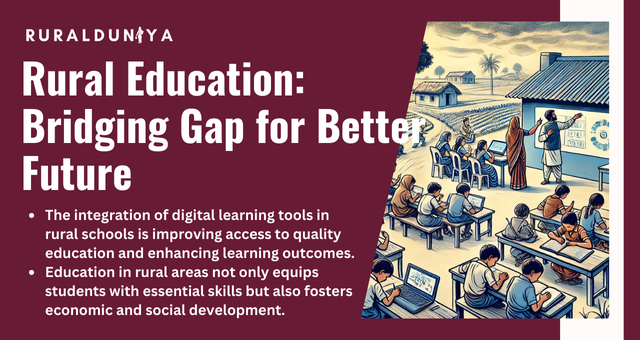
Rural education is a key driver of development, education is the foundation of a nation’s progress, and for India, where a significant population resides in rural areas. It not only empowers individuals but also strengthens communities by improving literacy rates, employability, and economic growth.
Despite government initiatives, it still struggles with issues like outdated curricula, gender disparities, and high dropout rates. Limited digital access further exacerbates the divide between rural and urban learners.
However, the rise of e-learning, digital classrooms, and community-based education initiatives is slowly changing the landscape. NGOs and government programs, such as the Sarva Shiksha Abhiyan and National Education Policy 2020, are making efforts to improve it.
The goal is to provide quality education that equips students with the skills needed for the modern workforce. Strengthening it can bridge the gap between urban and rural communities.
Definition of Rural Education
It refers to the educational system, facilities, and learning opportunities available in non-urban areas. It encompasses primary, secondary, and higher education institutions in villages and remote locations.
It aims to equip students with basic literacy, vocational skills, and knowledge that can contribute to local development and economic sustainability. Additionally, it emphasizes digital literacy, smart classrooms, and community-led learning programs.
Rural Education Centers
Centers are institutions dedicated to providing quality education in villages and underdeveloped regions. These centers include government schools, community learning spaces, NGOs, and digital learning hubs.
They aim to bridge educational gaps by offering affordable, accessible, and relevant education to rural students. Some notable centers include Ekal Vidyalaya, Pratham Education Foundation, and Teach for India initiatives in rural areas.
Mobile schools and rural ed-tech startups are also playing an essential role in improving education delivery.
Rural Education Development
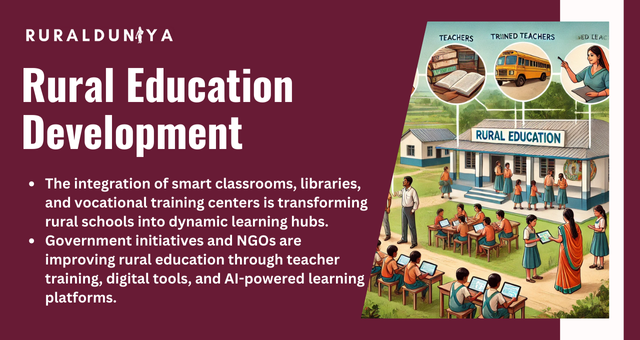
Developing it requires a multi-faceted approach that includes infrastructure improvement, teacher training, curriculum development, and technology integration.
Several government initiatives, such as the Rashtriya Madhyamik Shiksha Abhiyan (RMSA) and Samagra Shiksha Abhiyan, focus on providing financial aid, scholarships and free learning materials.
Additionally, corporate social responsibility (CSR) programs and NGOs are playing a vital role in improving the quality of it by establishing libraries, smart classrooms, and vocational training centers.
The implementation of artificial intelligence in education, language learning apps, and digital skill-based training are advancing education development.
Rural Education in India
India’s rural education system serves millions of children, but it faces significant challenges such as inadequate school infrastructure, teacher shortages, and high dropout rates, especially among girls.
According to the Annual Status of Education Report (ASER) 2023, while enrollment rates have improved, learning outcomes remain a concern.
The National Education Policy (NEP) 2020 emphasizes skill-based learning, early childhood education, and digital inclusion to uplift it standards. Encouraging STEM education in rural schools, vocational training, and scholarship programs for rural students can further enhance the system’s effectiveness.
Challenges in Rural Education
- Lack of Infrastructure: Many schools lack basic facilities such as classrooms, toilets, and drinking water.
- Shortage of Trained Teachers: Rural schools often suffer from a lack of qualified teachers, affecting learning outcomes.
- Limited Digital Access: Poor internet connectivity and lack of digital resources hinder e-learning opportunities.
- High Dropout Rates: Economic hardships force many students, especially girls, to leave school early.
- Outdated Curriculum: The existing curriculum often fails to provide practical and vocational skills needed for employment.
- Gender Disparity: Cultural norms and economic constraints result in fewer educational opportunities for girls.
Rural Education Mission
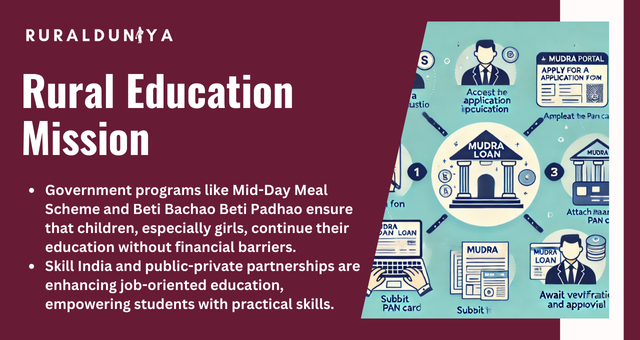
The mission of it is to provide accessible, affordable, and high-quality education to all children, regardless of their socio-economic background. Government initiatives like Mid-Day Meal Scheme, Beti Bachao Beti Padhao, and Skill India aim to encourage students to stay in school and pursue higher education.
The ultimate goal is to ensure every child in rural India receives an education that enables them to contribute meaningfully to society. Strengthening public-private partnerships, expanding vocational training, and integrating digital tools in it can drive long-term impact.
Importance of Rural Education in Rural Areas
- Economic Growth: Educated individuals contribute to the local economy by engaging in skilled jobs and entrepreneurship.
- Social Empowerment: Education helps reduce gender disparity, caste discrimination, and social inequality.
- Improved Healthcare Awareness: Literate individuals are more aware of health and hygiene practices, leading to better community health.
- Skill Development: Vocational training and skill-based education prepare students for self-employment and job opportunities.
- Technological Advancement: Digital learning and technology integration bring modern education to remote areas, reducing the digital divide and increasing digital literacy.
Rural Education vs. Urban Education
| Factors | Rural Education | Urban Education |
|---|---|---|
| Infrastructure | Basic, often inadequate | Advanced, well-equipped |
| Teacher Availability | Limited, often underqualified | Highly qualified, ample availability |
| Technology Access | Limited internet and digital tools | High-tech classrooms, e-learning available |
| Learning Outcomes | Lower literacy and skill levels | Higher literacy rates and competitive edge |
| Government Support | More government intervention needed | Better policy implementation and monitoring |
Rural Education System in India
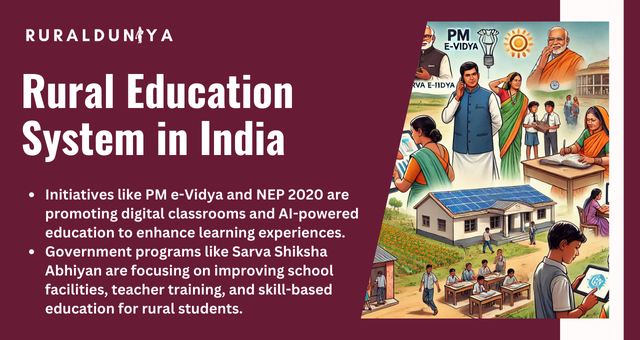
India’s rural education system primarily consists of government-run schools, supported by schemes such as Sarva Shiksha Abhiyan and PM e-Vidya.
The focus is on universal education, but challenges like multi-grade teaching, lack of subject-specialized teachers, and insufficient infrastructure persist.
The New Education Policy (NEP) 2020 has proposed reforms to address these gaps, emphasizing experiential learning, digital literacy, and skill development. Digital inclusion, teacher training, and AI-powered learning tools can transform it.
Rural Education Programs
Several programs and initiatives aim to strengthen it, including:
- Sarva Shiksha Abhiyan (SSA): Universalization of elementary education.
- Mid-Day Meal Scheme: Improves student retention by providing nutritious meals.
- Digital India Initiative: Encourages digital classrooms and e-learning in rural schools.
- PM SHRI Schools Initiative: Focuses on upgrading 14,500 schools across India to model institutions.
- UNICEF & NGO Collaborations: Support child education, teacher training, and school infrastructure.
- AI-Based Education Initiatives: Integrating artificial intelligence and interactive learning tools to enhance student engagement in rural schools.
Rural Education and Development Society
Organizations like the Rural Education and Development Society (REDS) work towards providing quality education, improving literacy rates, and promoting vocational training.
They collaborate with local communities, NGOs, and government agencies to implement education programs, build schools, and create awareness about the importance of learning in rural areas.
Micro-learning, community-driven teaching, and AI-powered education models are helping revolutionize it.
Final Thoughts
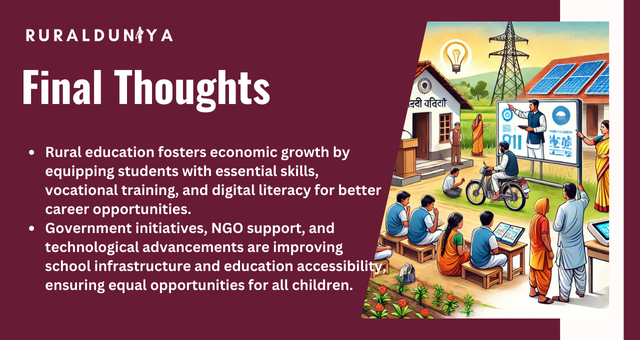
Rural education is a cornerstone of India’s development, playing a crucial role in empowering individuals and fostering economic growth.
While challenges persist, government initiatives, NGO efforts, and technological advancements are paving the way for a more inclusive and effective education system in rural areas.
Bridging the rural-urban education divide requires continued investment, innovation, and policy reforms to ensure that every child, regardless of location, receives quality education.
Strengthening it will ultimately contribute to a more skilled workforce, economic prosperity, and an equitable society for future generations.
FAQs
Why is rural education important?
It helps children gain knowledge, build skills, and improve their future. It also boosts local economies and reduces poverty.
What are the biggest challenges in rural education?
The main challenges include a lack of good schools, poor infrastructure, few trained teachers, and limited access to technology.
How can rural education be improved?
It can be improved with better teacher training, smart classrooms, digital learning, and more government and NGO support.
What is the role of technology in rural education?
Technology helps by providing online learning, smart classes, and access to quality education in remote villages.

Nishank is a social impact enthusiast with a solid foundation in public policy, micro-enterprise, and agribusiness. Growing up in a farmer’s family has given him a profound connection to rural communities, fueling his passion to empower people towards self-reliance. He completed his undergraduate studies at the Delhi University and earned a master’s degree in Rural Management from National Institute of Rural Development & Panchayati Raj in Hyderabad.



